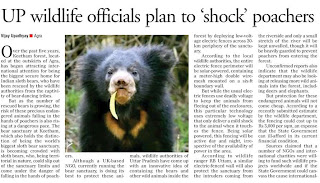A heritage lost
Situated barely a km away from the Taj Mahal, Diwanji Begum's tomb is a lost piece of Mughal history that nobody cared about till date. With the ASI working in full swing to conserve it, the perils surrounding it are blocking its way, says Vijay Upadhyay
It is a lost piece of Mughal history that nobody cared about till date. Now when the ASI has set off to re-discover and conserve history, there is very little left to conserve and that too, is going down in shambles due to the continuous danger posed by the locals who still treat this monument as a public urinal and recreational area despite the ASI taking it over for conservation.
Diwanji Begum, the mother-in- law of Emperor Shahjahan is considered to be one of the lesser known characters of the Mughal empire and till early this year, even the Archeological Survey of India was hardly aware that barely a km away from the Taj Mahal, the emperor's mother-in-law lay interred in a plain tomb, in sharp contrast to the ornate tomb of her daughter, Mariam-Uz-Zamani aka Mumtaz Mahal.
The tomb, located on a hillock deep inside the Diwanji Mohalla of Tajganj, about 1.5 km away from the Taj Mahal was since long being utilised by the locals as a public urinal before the ASI finally decided to "liberate" one of its lesser known monuments, with plans of raising it from the status of a garbage dump to a well-maintained Mughal -pattern garden for the tourists. It was only when the location of this "Gummat" as it is locally called, was matched with the Mughal era land records that the monument was identified as Diwanji Begum's tomb.
When The Pioneer team visited the monument, the locals, who were busy gambling inside the grave chamber till the ASI personnel accompanying this team demanded them to leave the premises, were curious to know if they would be allowed to enter the monument if the ASI finally developed the area into a Mughal garden.
Raghunath Singh Kushwah, a local muscleman who owns the land around the monument claimed that this monument was his ancestral property and he had been using it as a cow-shed for decades until the ASI displaced him from the land and covered it with a boundary wall. He demanded that the ASI should appoint someone from his family as a guard at the monument as a compensation for taking away his "birthplace".
Hari Singh, the ASI guard appointed at the monument said that the situation at the monument was still lawless and the locals had even beat up the guard posted here earlier, forcing him to go on a leave for almost eight months, when he tried to stop them from entering the premises.
Talking to The Pioneer, D Dayalan, Superintending Archaeologist, ASI Agra said that the tomb of Diwanji Begum was in the worst possible condition when discovered and taken over by the ASI early this year. The dome of the tomb had disappeared completely after caving in while the grave of Diwanji Begum too, had vanished, probably due to the act of some bounty-hunters who may have dug out the grave in the past history but so far, the ASI had failed to find any traces of the grave in the inner chamber with only a brick-layered floor laid out in the entire chamber though the age of the floor was yet to be determined.
Only the elaborately arched walls of the tomb had remained besides a complete network of five interconnected underground chambers just below the tomb structure, displaying the ideal Mughal architecture of a tomb with one main inner grave chamber and four smaller hexagonal grave chambers in the four corners. Like the monument, these cells too, were filled with the garbage from nearby settlements and had to be cleared before the conservation of the monument could begin.
Now, he said, the ASI had finally managed to partially restore the walls around the tomb as well as the underground cells and efforts were now on to develop a mughal-pattern garden around the tomb that shall be opened for the tourists within three months. He said that Archeological ideals restricted the ASI from reconstructing the dome of the tomb as there was no evidence left of the appearance or architecture of the dome and as a result, the monument shall be left as it is, without a dome, after the garden was developed by the horticulture branch of the ASI.


Comments
I am a architecture student for the UK and was wondering if you had anymore information about Diwanji Begum or the area around it? Please get in touch if you do on
NSC0037@my.londonmet.ac.uk
Thanks!
I am an architecture student from the UK and I was wondering if you had anymore information about Diwangi Begum's tomb or the surrounding area. Please get in touch if you do via NSC0037@my.londonmet.ac.uk
Thanks